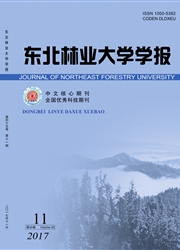

 中文摘要:
中文摘要:
采用盆栽法系统地研究了梨(Pyrus ussriensis Max.)、李(Prunus salicina Lindl.)、杏(Armeniaca vulgaris Lam.)幼苗在土壤重金属镉胁迫下的生理生化反应。结果表明:3个树种随着重金属质量分数和胁迫时间的增加,各树种叶片的叶绿素质量分数降低,其中杏树的降幅最大,李树居中,梨树最小;相对电导率有逐渐升高的趋势;叶片MDA质量摩尔浓度均出现先降低后升高的趋势;POD活性随土壤中镉质量分数的增加先升高后降低;脯氨酸质量分数随着重金属胁迫时间的延长有不断积累的趋势。综合评定3树种对土壤镉的抗性为梨树〉李树〉杏树。
 英文摘要:
英文摘要:
The physiological and biochemical responses of pear( Pyrus ussuriensis Max. ), plum( Prunus salicina Lindl. ) and apricot(Armeniaca vulgaris Lam. )potted seedlings were studied under cadmium stress in a greenhouse. Results showed that, with cadmium concentration and stress time increasing, the chlorophyll content in the leaves of the three fruit tree species declined, and the decreasing range was in the order of apricot, plum, and pear from high to low; relative conductivity of the leaves showed an increasing tendency; MDA content first decreased and then increased; POD activity first increased and then decreased; proline content also exhibited an increasing tendency. The resistance of the three fruit tree species to cadmium indicated pear 〉 plum 〉 apricot by synthetic evaluation.
 同期刊论文项目
同期刊论文项目
 同项目期刊论文
同项目期刊论文
 期刊信息
期刊信息
